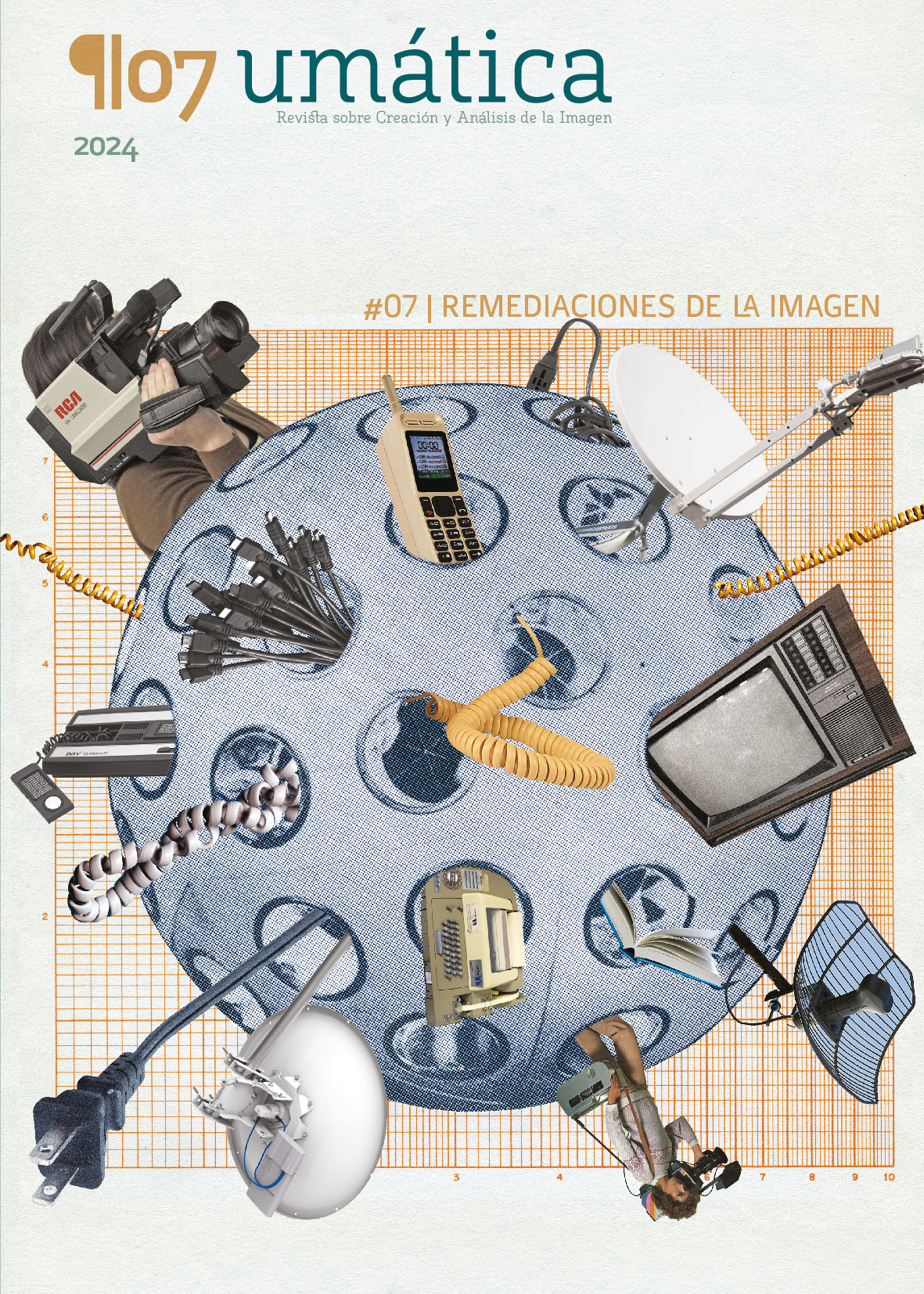Remediations of the Image: Audiovisualizations and (Dis)Appropriations of the History of Art and the Visual Culture
DOI:
https://doi.org/10.24310/umatica.2024.v6i7.21030Keywords:
Ways of Seeing, remediation, image, audiovisualization, (dis)pppropriations, television, art history, visual cultureAbstract
The appearance of the television series Ways of Seeing in 1972, and the subsequent book of the same name, represented a radical intervention in the canonical narratives of art history that quickly became a project as admired as it was criticized. More than fifty years later, Ways of Seeing continues to arouse interest for the irreverent strategies it implemented: image remediation and montage, collaborative writing, modes of (dis)appropriation, and other non-linear ways of narrating art history from critically situated experiences.
Although these characteristics positioned Ways of Seeing as a crucial reference in the English-speaking world, in the Spanish-speaking context this influence does not seem to have had the same extent. In order to contribute to the debate on the relevance and validity of Ways of Seeing, the seventh issue of Umática integrates a set of reflections on different remediations of images, especially from Latin America and Spain. These are investigations based on exercises and experiments that dodge the conceptual and institutional architecture of authorship, ownership, genius and the male gaze, among other characteristics of the canon of Western art history.
In order to approach the remediation of images from this particular perspective, we have situated the debate around two fundamental notions: the audiovisualization of art history and the (dis)appropriation of visual culture. As complementary processes, these notions operate transversally throughout the different discussions of this monograph. Following Ways of Seeing, this issue brings together works that go beyond disciplinary boundaries and admit approaches such as the political philosophy of the image, feminist positions, reflections on audiovisual ecologies, reconceptualization of archives, critical pedagogy initiatives and other theoretical and methodological perspectives that, from their hybridity, venture into the various experiments opened up by the processes of audiovisualization of art history and (dis)appropriation of visual culture. This is neither a tribute nor an exhaustive review of Ways of Seeing, but rather the exploration of its possible remediations, contradictions and readjustments, more than fifty years after its appearance and in latitudes that surpass its frame of origin.
Downloads
Metrics
Publication Facts
Reviewer profiles N/A
Author statements
Indexed in
-
—
- Academic society
- N/A
- Publisher
- Universidad de Málaga (España)
References
Bolter, J. D. y Grusin, R. (2000). Remediation. Understanding New Media. The MIT Press.
Boyle, D. (1997). Subject to Change. Guerrilla Television Revisited. Oxford University Press.
Conlin, J. (2020). Lost in Transmission? John Berger and the Origins of Ways of Seeing (1972). History Workshop Journal, 90. https://doi.org/10.1093/hwj/dbaa020
Dyer, G. (1986). Ways of Telling: The Work of John Berger. Pluto Press.
Enzensberger, H. M. (1981). Elementos para una teoría de los medios de comunicación. Editorial Anagrama.
Fuller, P. (1981). Seeing Berger. A Revaluation of Ways of Seeing. Writers and Readers Publishing Cooperative.
Gould, S. y Leblond, D. (Eds.). (2023). Fifty Years of Seeing with John Berger. Études britanniques contemporaines, (65). https://doi.org/10.4000/ebc.13853
Hall, S. (1973). Encoding and decoding in the television discourse. [Discussion Paper]. University of Birmingham.
Kalkstein, M. (2019). Aby Warburg’s Mnemosyne Atlas: On Photography, Archives, and the Afterlife of Images. Rutgers Art Review, 35. 50-73.
Karlholm, D. (2010). Developing the Picture: Wölfflin’s Performance Art. Photography and Culture, 3(2), 207-215. http://dx.doi.org/10.2752/175145110X12700318320512
Kember, S. y Zylinska, J. (2012). Life After New Media: Mediation as a Vital Process. The MIT Press.
Levin, E. (2022). The Channeled Image. Art and Media Politics after Television. The University of Chicago Press
López Cuenca, A. (2018). ¿De quiénes son las imágenes? La Historia del arte en la era Betamax. En García Pérez, V. (Ed.), La vorágine de las imágenes. Accesos, circuitos, controles, archivos y autorías en el arte (pp. 17-41). Instituto Nacional de Bellas Artes.
López Cuenca, A. y Bermúdez Dini, R. (Eds.). (2024). Nociones en común. Hacia un glosario para liberar la cultura. Centro de Cultura Digital.
McCarthy, A. (2001). Ambient television: Visual Culture and Public Space. Duke University Press.
Mitchell, W. J. T. (1986). Iconology: Image, Text, Ideology. University of Chicago Press.
Negt, O., y Kluge, A. (1993). Public Sphere and Experience. Toward an Analysis of the Bourgeois and Proletarian Public Sphere. The University of Minnesota Press.
Parks, L. y Schwoch, J. (2012). Down to Earth. Satellite Technologies, Industries, and Cultures. Rutgers University Press.
Pehlivan, S. y Şener, D. K. (2014). Photography and art history: the history of art born from photography. Procedia - Social and Behavioral Sciences, 122, 210–214. http://dx.doi.org/10.1016/j.sbspro.2014.01.1329
Pollock, G. (1988). Vision and Difference. Feminism, Femininity and Histories of Art. Routledge.
Preziosi, D. (1989). Rethinking Art History. Meditations on a Coy Science. Yale University Press.
Ramírez, J. A. (1976). Medios de masas e historia del arte. Cátedra.
Rees, A. L. y Borzello, F. (Eds.). (1986). The New Art History. Camden Press.
Rivera Garza, C. (2013). Los muertos indóciles. Necroescrituras y desapropiación. Tusquets Editores.
Rivera Garza, C. (2021). Desapropiación para principiantes. Thesavrvs, 60(1), 106-116. https://thesaurus.caroycuervo.gov.co/index.php/rth/article/view/16
Silverstone, R. (1994). Television and Everyday Life. Routledge.
Spampinato, F. (2022). Art vs. TV. A Brief History of Contemporary Artists’ Responses to Television. Bloomsbury.
Sperling, J. (2019). Ways of Living. https://aeon.co/essays/john-bergers-ways-of-seeing-and-his-search-for-home
Spigel, L. (1992). Make Room for TV: Television and the Family Ideal in Postwar America. Chicago: University of Chicago Press.
Streeter, T. (1996). Selling the Air. A Critique of the Policy of Commercial Broadcasting in the United States. The University of Chicago Press.
Thomson, B. (1979). Television and the Teaching of Art History. The Oxford Art Journal, 2(3), 46-49.
Walker, J. A. (1993). Arts TV: A History of Arts Television in Britain. John Libbey.
Williams, R. (1974). Television: Technology and Cultural Form. Routledge.
Wood, C. (2019). A History of Art History. Princeton University Press.
Wyver, J. (2007). Vision On. Film, Television and the Arts in Britain. Wallflowers Press.
Zielinski, S. (1999). Audiovisions. Cinema and Television as Entr'Actes in History. Amsterdam University Press.
Downloads
Published
How to Cite
Issue
Section
License
Copyright (c) 2024 Renato Bermúdez Dini , Marilyn Payrol Morán, Alma Cardoso Martínez

This work is licensed under a Creative Commons Attribution-NonCommercial-ShareAlike 4.0 International License.
All contens publishes in Umática.Revista sobre Creación y Anáisis de la Imágen are protected under the Creative Commos Attribution-NonComercial-ShareAlike 4.0 International (CC-BY-NC-SA 4.0) license.
All about this license is available in the following link: <http://creativecommons.org/licenses/by-nc-sa/4.0>
Users can copy, use, redistribute, share and exhibit publicly as long as:
- The original source and authorship of the material are cited (Journal, Publisher and URL of the work).
- It is not used for comercial purposes.
- The existence of the license and its especifications are mentioned.
There are two sets of authors’ rights: moral and property rights. Moral rights are perpetual prerogatives, unrenounceable, not-transferable, unalienable, imprescriptible and inembargable. According to authors’ rights legislation, Umática.Revista sobre Creación y Anáisis de la Imágen recognizes and respects authors moral rights, as well as the ownership of property rights, which will be transferred to University of Malaga in open access. The property rights are referred to the benefits that are gained by the use or the dissemination of works. Fotocinema. Umática.Revista sobre Creación y Anáisis de la Imágen is published in an open access form and it is exclusively licenced by any means for doing or authorising distribution, dissemination, reproduction, , adaptation, translation or arrangement of works.
Authors are responsable for obtaining the necessary permission to use copyrighted images.
Copyright note: Authors who have publications with this journal agree and certify to the following terms:
- That he/she has contributed directly to the intellectual content of the work, for which he/she is responsible for all purposes.
- That he/she approves the contents of the manuscript submitted to the editorial process of UMÁTICA, REVISTA SOBRE CREACIÓN Y ANÁLISIS DE LA IMAGEN, and therefore agrees that his/her name appears as the author(s).
- That the content of the article has not been published and that it does not appear in any other work that is about to be published.
- That he/she agrees not to submit it for consideration of another publication while it is in the process of being reviewed by UMÁTICA, REVISTA SOBRE CREACIÓN Y ANÁLISIS DE LA IMAGEN, nor later in case it is accepted for publication.
- That he/she has not had, nor does any personal or financial affiliations that could prejudice the development or results of the present work.
- That all those persons who have made a substantial contribution to the development of the work, having given their permission for the mention, have been mentioned in the acknowledgments section.
- That he/she agrees to provide, when required by the journal, access to all the data and sources on which the work presented is based.
- That he/she will actively participate in the realization of all those stylistic or orthographic-typographic modifications necessary for the publication of the work when notified by the journal's editorial team.
- That he/she has not violated, and nor will, the laws and human or animal rights during the process of research and publication of this work.
- That, none of the institutions in which he/she carries out his/her scientific and research work has presented objections to the publication of the manuscript submitted for evaluation.
- That data and references to materials published are credited and included in the references and citations and, in the cases required, have the due authorizations of those who own the patrimonial rights.
- That any material used is free of copyright. Author(s) is responsible for any litigation or claim related to intellectual property rights, exonerating UMÁTICA, REVISTA SOBRE CREACIÓN Y ANÁLISIS DE LA IMAGEN (UMÁTICA, CREATION AND ANALYSIS OF IMAGE JOURNAL) of any responsibility.
- That in case the work is approved for publication, authorizes the publisher to include the text in the journal UMÁTICA, REVISTA SOBRE CREACIÓN Y ANÁLISIS DE LA IMAGEN and to reproduce, edit, distribute, exhibit and communicate it in the country and abroad by printed, electronic, CD, Internet or any other means known or to be known.







23.png)






